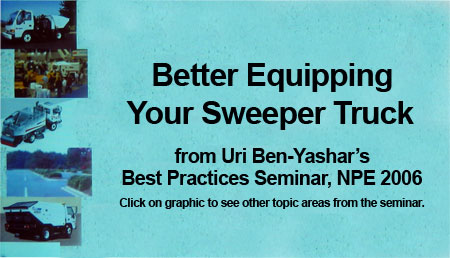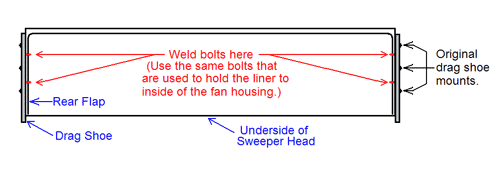Best Practices |
Better Equipping Your Sweeper Trucks
This information was provided, in part, by one of the focus groups at the seminar organized by Uri Ben-Yashar at NPE 2006. This focus group provided a number of great ideas for better equipping a parking area sweeper.Topic area moderator was Karl Stauty, who heads up Commercial Power Sweeping, Inc. Presenter was Todd Wilson, principal of New England Power Sweeping Service.by Ranger Kidwell-Ross
It's about the same price to fabricate heavy steel bumpers, according to Ray Confer, of C & J Sweeping. Ray also offered an operating tip concerning bumpers, which is that they spray paint the corners of their bumpers with white paint, then watch to see which drivers are scraping the paint off when they turn. Those drivers with the most scrapes on their bumper paint are the ones who get the old sweepers when the new ones come in. Problem: Some of the dumpsters that are now locking are built such that the sweeper won't match up when they dump. Karl Stauty, of Commercial Power Sweeping, puts a 4" piece of steel between the bumper and the rubber extension on the back. Then, he uses a rear flap to act as an extension at the top of the hopper. That way, the sweeper can dump out the debris without hitting the dumpster. 
Backpack blowers are a constant problem, from keeping them from getting stolen to making sure drivers use them at the appropriate times. Some contractors have a chain going through a loop and they lock the blower onto the truck. Because of the time and hassle to put them on and off each time they're used, some contractors have also gone to hand-held blowers. One contractor uses a milk crate that fits right behind the driver's side of the chassis to use to set the blower in when it's not in use. They just keep the blower running and then it's easy for the driver to jump out of the truck to use it whenever needed. Others have a system where they find somewhere to leave the blower hanging so it's ready for use. There was general agreement that, unless you make it quick and easy for operators to get to the blower and use it, they won't use it as often as they should. What to do with full trash bags was another topic covered by this group. Stauty has racks of expanded steel fabricated for the back of his sweepers. These fold up and down to put full bags onto. Uri said they have fabbed racks that fit between the cab and the hopper. Either way, this was considered a problem with current sweeper designs by many in the room, since with parking area sweeping many accounts include trash bag liner replacements. Communications was the next topic covered. Majority of driver/office communications seemed to be done via Nextel, however most did not use Nextel for their GPS service. Interior wear: Brainstorming was done about ways to keep the inside of the cabs from becoming 'trashed.' Seatcovers are one high wear item that many contractors want to do something to alleviate. At the WorldSweeper.com Tip Clipboard is a tip on using bulletproof vest material to make seatcovers out of. Cordura has also proved effective for the same purpose and for riding gear in the motorcycle industry. If you use cordura, keep in mind that the higher the number (denier), the stronger and more abrasion-resistant the material will prove to be. It was thought that 1800 denier was tops, as compared to the light 200 denier that is standardly used on suitcases. To address floor wear, it was suggested that 1/4" rubber floor mats be purchased when the sweeper is new. These should be large enough to cover the whole floor including under the trim. Then, they can be screwed down at the edges through the trim holes so they'll stay in place. When the original equipment mats wear as guys get in and out all the time, it ends up exposing the wiring that runs around the edges of the floor. Once that happens, the wires start getting broken and creating shorts. The general recommendation was to replace the 'over mats' about once a year. Suggestions re: the outside of the trucks: There was general agreement that there can be problems with the flashing lights on the barlight when you're doing parking lot sweeping. In some cases, it attracts unwanted police attention. In others, it's bothersome to people trying to sleep in residential areas bordering an account. An idea that Stauty said he copied from Waste Management is to hang a gel-filled beacon underneath the chassis. Instead of flashing to a far distance like a barlight, it puts light out along the ground. This retains the safety aspect of having a flashing beacon, yet puts the light down where it serves as an even better warning when someone is nearby to the sweeper, which can help prevent accidents. Another big advantage is the lower flashing beacon doesn't flash into bedroom windows at the perimeter of the lot, thereby reducing noise and other operational complaints. A perennial problem with sweepers has been chafing of hydraulic hoses and wiring where they run along the frame. As they rub, they wear, creating hydraulic failures and wiring shorts. Some ideas that are being used include, on a new sweeper, to wrap the frame rails with 1/2" rubber, perhaps using rear flap material. The fact that it's rubber-covered keeps the frame from being able to abrade the hoses or wiring. You can also tie the hoses and wires down so they are unable to move up and down with the movement of the sweeper. Drag shoe adjustment: On most sweepers, when you adjust the drag shoe it can put the flap out of adjustment. Stauty welds two bolts on the underside of the head. These are the same bolts that are used to hold the liner to the housing. Then, they use those bolts to attach the rear flap. By doing this, the drag shoe adjustment becomes independent of the flaps. The adjustment becomes faster and easier. 
Put a mud flap at the top edge of the inlet tube, positioned so that it 'dangles' such that it can deflect debris as it comes into the hopper. Doing this can be more effective than the chains. Issues reported on Elgin Eagle drag shoes: When the stock plastic drag shoes were replaced with carbide shoes they lasted much longer. More durability, less maintenance. Bolt a piece of thick rubber between the drag shoe and the mount, which allows the drag shoes to flex a little when they're run into something. This keeps them from bending as easily. One perennial problem in the industry has been engine failure from dirt getting into the engine when the air filters are changed out. The suggestion is to add an air pre-filter inline in front of the regular air filter as a 'supplement.' This can then be changed out relatively more often, providing the benefit of having the regular air filter last longer, as well as having no opportunity to get dirt into the engine when the pre-filter is changed. There was general agreement about the value of 'filter minders,' which are a device that has a popup when the air restriction due to a dirty filter reaches the point where the air filter should be changed out. The inclination with many sweeper owners is to change out the filters too often, since the sweepers work in such a dusty environment. This can create more problems than it solves, since only a tablespoon of dirt getting in over time can ruin an engine. The high cost of parts between OEM and aftermarket suppliers was another topic that was touched upon in passing. General agreement was that it was worth shopping around for any parts that were available as aftermarket items. Caution is to really inspect any aftermarket parts that are purchased to see how they compare to those supplied as OEM by the sweeper manufacturer. If you have any questions about any of the above ideas, feel free to contact the WorldSweeper.com Team for a further explanation. |
© 2005 - 2012
|
Parking Area Sweeping Contents
|